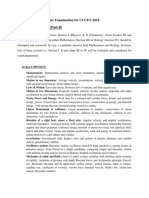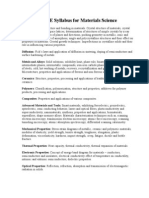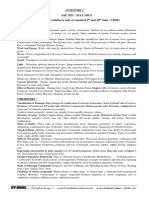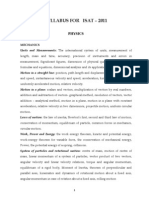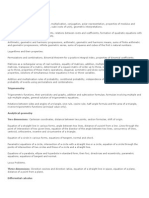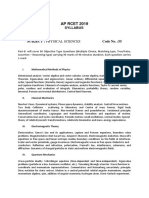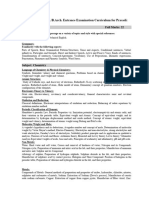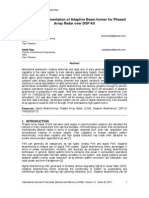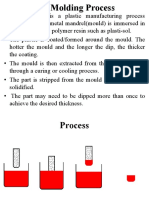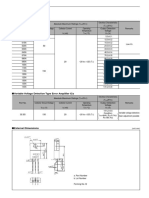Course Detail Short ECE
Uploaded by
Vaibhav NarulaCourse Detail Short ECE
Uploaded by
Vaibhav NarulaCourse Detail
Subjects of Relevance to my degree of Electronics and Communication (Physics, Chemistry, Mathematics) in first few pages.
Applied Mathematics 1
COMPLEX NUMBERS AND INFINITE SERIES: De Moivres theorem and roots of complex numbers. Eulers theorem, Logarithmic Functions, Circular, Hyperbolic Functions and their Inverses. Convergence and Divergence of Infinite series, Comparison test dAlemberts ratio test. Higher ratio test, Cauchys root test. Alternating series, Lebnitz test, Absolute and conditioinal convergence. CALCULUS OF ONE VARIABLE: Successive differentiation. Leibnitz theorem (without proof) McLaurins and Taylors expansion of functions, errors and approximation. Asymptotes of Cartesian curves. Curveture of curves in Cartesian, parametric and polar coordinates, Tracing of curves in Cartesian, parametric and polar coordinates (like conics, astroid, hypocycloid, Folium of Descartes, Cycloid, Circle, Cardiode, Lemniscate of Bernoulli, equiangular spiral). Reduction Formulae for evaluating Finding area under the curves, Length of the curves, volume and surface of solids of revolution.
LINEAR ALGEBRA MATERICES: Rank of matrix, Linear transformations, Hermitian and skeew Hermitian forms, Inverse of matrix by elementary operations. Consistency of linear simultaneous equations, Diagonalisation of a matrix, Eigen values and eigen vectors. Caley Hamilton theorem (without proof). ORDINARY DIFFERENTIAL EQUATIONS: First order differential equations exact and reducible to exact form. Linear differential equations of higher order with constant coefficients. Solution of simultaneous differential equations. Variation of parameters, Solution of homogeneous differential equations Canchy and Legendre forms.
Applied Physics 1
Interference of Light: Interference due to division of wavefront and division of amplitude, Youngs double slit expt., Interference, Principle of Superposition, Theory of Biprism, Interference from parallel thin films, wedge shaped films, Newton rings, Michelson interferometer.
Diffraction: Fresnel Diffraction, Diffraction at a straight edge, Fraunhoffer diffraction due to N slits, Diffraction grating, absent spectra, dispersive power of Grating, resolving power of prism and grating. Polarization: Introduction, production of plane polarized light by different methods, Brewster and Malus Laws. Double refraction, Quarter & half wave plate, Nicol prism, specific rotation, Laurents half shade polarimeter. Optical Instruments : Ramdson & Huygen Eye pieces, Electron microscope. Laser: Introduction, temporal and spatial coherence, principle of Laser, stimulated and spontaneous emission, Einsteins Coefficients, He-Ne Laser, Ruby Laser, Application of Lasers. Fibre Optics: Introduction, numerical aperture, step index and graded index fibres, attenuation & dispersion mechanism in optical fibers (Qualitative only), application of optical fibres, optical communication (block diagram only) Mechanics: Central and non-central forces, Inverse square force, SHM, Damped, undamped and forced Oscillations. Special theory of Relativity: Frame of reference, Michelson-Morley experiment, basic postulates of special relativity, Lorentz transformations (space time coordinates & velocity only), mass energy relation.
Applied Chemistry 1
Water: Specifications for water, analysis of water alkalinity, hardness and its determination (EDTA method only). Water for domestic use, Water softening processes Lime Soda process, Ion exchange method, boiler feed water, boiler problems-scale, sludge, priming and foaming, caustic embitterment and corrosion, their causes and prevention, removal of silica, removal of dissolved gases, carbonate and phosphate conditioning, colloidal conditioning, calgon treatment, Numerical problems on alkalinity, hardness, LimeSoda process and Ion exchange method, EDTA method. Fuels: Classification, combustion and chemical principles involved in it, calorific value: gross and net calorific values and their determination by bomb calorimeter and Boys gas calorimeter. Solid Fuels: Proximate and ultimate analysis of coal and their importance, High and low temperature carbonisation, Coke: Its manufacture by Otto Hoffman oven.
Liquid Fuels: Conversion of coal into liquid fuels (Bergius process and Fisher-Tropsch Process) and mechanism, Petroleum: its chemical composition and fractional distillation, cracking of heavy oil residues thermal and catalytic cracking, knocking and chemical structure, octane number and cetane number and their significance, power alcohol, Analysis of flue gases by Orsats apparatus, Numerical on calorific value, combustion, proximate and ultimate analysis of coal, flue gas analysis. Environmental Pollution and Control: Air Pollution: Types of pollutants, source effects, sink and control of primary pollutants CO, Nox, HC, Sox and particulates, effects of pollutants on man and environment photochemical smog and acid rain. Water Pollution: Classification of pollutants, their sources, waste water treatment domestic and industrial. Soil Pollution: Composition of soil, classification and effects of soil pollutants and their control. Solid Waste Pollution: Classification, waste treatment & Disposal methods (Composting, sanitary landfilling, thermal processes, recycling and reuse). Hazardous Wastes: Classification radioactive, biomedical and chemical, treatment and disposal physical, chemical and biological processes. Solutions: Ideal and non-ideal solutions, Raoults Law, Distillation of binary solutions, Henrys Law, Nernst distribution law, Arrhenius theory and special behaviour of strong electrolytes. Corrosion: Types of corrosion (dry, wet, atmospheric and soil corrosion), theories of corrosion, protective measures against corrosion.
Applied Mathematics II
CALCULUS OF SEVERAL VARIABLES: Partial differentiation, ordinary derivatives of first and second order in terms of partial derivaties, Eulers theorem on homogeneous functions, change of variables, Taylors theorem of two variables and its application to approximate errors. Maxima and Minima of two variables, Langranges method of undermined multipliers and Jacobians.
FUNCTIONS OF COMPLEX VARIABLES:
Derivatives of complex functions, Analytic functions, Cauchy-Riemann equations, Harmonic Conjugates, Conformal mapping, Standard mappings linear, square, inverse and bilinear. Complex line integral, Cauchys integral theorem, Cauchys integral formula, Zeros and Singularities / Taylor series, Laurents series, Calculation of residues. Residue theorem, Evaluation and real integrals. VECTOR CALCULUS: Scalar and Vector point functions, Gradient, Divergence, Curl with geometrical physical interpretations, Directional: derivatives, Properties. Line integrals and application to work done, Greens Lemma, Surface integrals and Volume integrals, Stokes theorem and Gauss divergence theorem (both without proof). LAPLACE TRANSFORMATION: Existence condition, Laplace transform of standard functions, Properties, Inverse Laplace transform of functions using partial fractions, Convolution and coinvolution theorem. Solving linear differential equations using Laplace transform. Unit step function, Impulse function and Periodic function and their transforms.
Applied Physics II
Electromagnetic Theory (EMT) Motion of Charged Particles in crossed electric & magnetic fields, Velocity Selector & Magnetic focussing, Gauss law, continuity equation, inconsistency in Amperes Law, Maxwells equations (differential and integral forms), poynting vector, Poynting Theorem (Statement only), propagation of plane electromagnetic waves in conducting and nonconducting medium. Quantum Mechanics & Statistical Physics: De-Broglie Hypothesis, Davisson Germer experiment, wave function and its properties, expectation value, Wave Packet, Uncertainity principle. Schrodinger Equation for free Particle, Time Dependent Schrodinger Equation, Particle in a box (1-D), Single step Barrier, Tunneling effect. Qualitative Features of Maxwell Bollzman, Bose-Einstein and Fermi-Dirac statistics distribution, functions & their comparison (no derivation) Solid State Physics
Formation of energy bands in metals, semiconductors and insulators; intrinsic and extrinsic semiconductors, Fermi energy levels for doped, undoped semiconductors and pn junction; Tunnel diode, Zener diode. Superconductivity: Meissner Effect, Type I and Type II Superconductors, BCS theory (Qualitative only), Londons equation, properties of superconductors & applications.
X-Rays: production and properties, Crystalline and Anorphous solids (Brief) Braggs Law, Applications. Ultrasonics: Introduction, Production of Ultrasonics (Magentostriction and piezoelectric methods), engineering applications.
Applied Chemistry II
Chemical Bonding: Potential Energy curve for H2 molecule, co-ordinate bond, Werners theory, effective atomic numbers, isomerism in co-ordinate compounds. Hydrogen bonding, Vander Waals forces, hybridization including d-orbitals, Valence shell Electron Repulsion Theory (VSEPR). Discussion of structures of IF3, SnCl2, CO32-, Molecular Orbital theory, Linear combination of atomic orbitals (LCAO) method. Structures of simple heteronuclear diatomic molecules such as CO, NO, HF, HCl. Gaseous State: Gas laws and Kinetic theory of gases, Distribution of molecular velocities, Mean free path, Real gases non ideal behaviour, causes of deviation from ideal behaviour, Vander Waals equation. Liquefaction of gases. Numericals based on above topics. Thermochemistry: Hesss Law, Heat of a reaction, Effect of temperature on heat of reaction at constant pressure (Kirchoffs eq.), heat of dilution, heat of hydration, heat of neutralization and heat of combustion, Flame temperature. Catalysis: Criteria for catalysis : Homogeneous catalysis acid-base, Enzymatic catalysis, Catalysis by metal salts, Heterogeneous catalysis, concepts of promoters, inhibitors and poisoning, physiosorption, chemisorption, surface area. The Phase Rule: Definitions of various terms, Gibbs Phase rule, Application of phase rule to one component system the water system and Sulphur system. Two component system : Lead Silver, FeCl3 water, Na2SO4 water.
Polymers and Composites: Functionality, Degree of polymerization, concept of molecular weight (number average, weight average & numerical based on them), Linear, branched and cross-linked polymers, Tacticity of polymers, Homo and Copolymers (Classification based on repeat unit), Structure property relationship of polymers. Industrial applications of important thermoplastic, thermosetting polymers, Elastomers, Natural Polymers. Conducting Polymers : Properties and applications. Composites : Classification, Fibre and particle reinforced composite
Applied Mathematics III
Laplace Transformation: Laplace Transformation, Inverse Laplace transformation Convolution Theorem, application to linear differential equations with constant coefficients, Unit step function, impulse functions / periodic functions. Fourier Series: Fourier Series, Eulers formulae, even and odd functions, having arbitrary periods, half range expansion, Harmonic Analysis. Fourier Transforms: Fourier transform, Sine and Cosine transforms, Application to differential equations. Special Functions: Beta and Gamma functions, Bessels functions of first kind, Recurrence relations, modified Bessel functions of first kind, Ber and Be functions, Legendre Polynomial, Rodrigues formula, orthogonal expansion of function. Partial Differential Equation: Formation of first and second order linear equations, Laplace, Wave and heat conduction equation, initial and boundary value problems.
ELECTRICAL SCIENCE
Circuit Analysis Ohms Law, KCL, KVL Mesh and Nodal Analysis, Circuit parameters, energy storage aspects, Superposition, Thevenins, Nortons, Reciprocity, Maximum Power Transfer Theorem, Millmans Theorem, Star-Delta Transformation. Application of theorem to the Analysis of dc circuits. A.C.Circuits R-L, R-C, R-L-C circuits (series and parallel), Time Constant, Phasor representation, Response of R-L, R-C and R-L-C circuit to soinusoidal input Resonance-series and parallel R-L-C Circuits, Q-factor, Bandwidth.
Measuring Instruments Principles, Construction and application of moving coil, moving iron, dynamometer type, induction type instruments, extension of range of ammeter, voltmeter (shunt and multiplier), Two-wattmeter method, for the measurement of power, Cathol-ray Oscilloscope and Applications. Transformers Construction and Working principles and phaser diagrams of Single-phase Transformer, Emf equation,Equivalent circuit, Regulation and efficiency, and Auto transformer. Rotating Machines Construction and working principles of dc motor and generator and its characteristics Applications of DC machines. Construction and working principles of 3- -Induction motor, Torque-speed characteristics, and Industrial applications.
Optical Communication
Introduction: Measurement of Information, Channel Capacity, Communication System Architecture, Basic Optical Communication System, Advantage of Optical Communication System.Propagation in Dielectric Waveguides: Introduction, Step-index Fibers, Graded Index Fibers, Modes & Rays, Slab Wave Guide. Attenuation in Optical Fibers: Introduction, Absorption, Scattering, Very Low Loss Materials, All Plastic & Polymer-Clad-Silica FibersS Wave Propagation: Wave Propagation in Step-Index & Graded Index Fiber, Overall Fiber Dispersion-Single Mode Fibers, Multimode Fibers, Dispersion-Shifted Fiber, Dispersion, Flattened Fiber, Polarization. Source & Detectors: Design of LED's for Optical Communication, Semiconductor Lasers for Optical Fiber Communication System, Semiconductor Photodiode Detectors, Avalanche Photodiode Detectors & Photo multiplier Tubes. Optical Fiber Communication System: Telecommunication, Local Distribution Series, Computer Networks Local Data Transmission & Telemetry, Digital Optical Fiber Communication System-First Generation, System, Second Generation System, Future System. Data Communication Networks- Network Topologies, Mac Protocols, Analog System. Advanced Multiplexing Strategies- Optical TDM, Sub carrier Multiplexing, WDM Network Architecutres; SONET/SDH, Optical Transport Network, Optical Access Network, Optical Premise Network.
Applications-Military Applications, Civil, Consumer & Industrial Applications.
Signal & Systems
Unit I Introduction : Basic concepts & Definitions ,Continuous and Discrete Time Signals & their Classification , Continuous & Discrete Time system & their properties . Basic Signals. Linear Time Invariant Systems : Convolution for contininous- time systems (CTS), convolution for Discreet-time systems (DTS), properties of LTI systems , Strate variable Description for LTI systems. Correlation. Unit II Fourier Analysis for CTS: Response of LTI systems to Exponential Signals, Periodic signals,Fourier Series ,Fourier Transform and its Properites, system Analysis by fourier Transform. Fourier Analysis for DTS : Response of LTI system to Exponentials Signals, Discrete Time Fourier series , Discrete- time Fourier transform & its Properties,System Analysis by Fourier Transform. Unit III Time and Frequency Characterization of Signals and Systems: The Magnitude Phase Representation of the Fourier Transform , Linear and Non Linear phase , phase Delay and Group Delay , Time Domain properties of Ideal Frequency Selective filters , Time- Domain and Frequency Domain Aspects of Non Ideal Filters. Sampling : The sampling Theorem ,Effect of under sampling , Sampling of Band Pass signals. Unit - IV Laplace Transform : Definition and Properties , Methods ofInversion ,Application to LTI system Analysis. Z- Transform : Definitions and Properties, Significance and properties of ROC , Inversion oz Z- Transform , Application to system Analysis ,The Unilateral Z-Transform and its Properties.
Circuits and Systems
Unit-I Introduction to continuous and discrete signals, their classification and types, periodic waveforms and signal synthesis, LTI systems and their properties; system modeling in terms of differential equations and transient response of R, L, C circuits for impulse, step, ramp, sinusoidal and exponential signals. Unit-II Laplace Transform: Review of properties and applications of Laplace transform of complex waveform and transient response of R, L, C series, parallel, series-parallel circuits for all kinds of excitations. Unit-III Graph theory and its applications, two port networks z, y, ABCD, h, g, inverse ABCD parameters their interconversion, interconnection of two 2-port networks, concept of transform impedance, Network theorems: Reciprocity, Superposition, Thevenin, Norton, Millman, Maximum Power Transfer and Tellegan
Analog Electronics I
Unit I Semiconductor Diodes and Rectifiers: Introduction, general characteristics, energy levels, extrinsic materials n & p type, ideal diode, basic construction and characteristics, DC & AC resistance, equivalent circuits, drift & diffusion currents, transition & diffusion capacitance, reverse recovery times, temperature effects, diode specifications, different types of diodes (Zener, Varactor, Schottky, Power, Tunnel, Photodiode & LED). Half wave & full wave rectifiers. [ Unit II Bipolar junction transistor: Introduction, Transistor, construction, transistor operations, BJT characteristics, load line, operating point, leakage currents, saturation and cut off mode of operations Eber-molls model. Bias stabilization: Need for stabilization, fixed Bias, emitter bias, self bias, bias stability with respect to variations in Ico, VBE & , Stabilization factors, thermal stability. Small signal amplifiers: CB, CE, CC configurations, hybrid model for transistor at low frequencies, RC coupled amplifiers, mid band model, gain & impedance, comparisons of different configurations, Darlington pair, Hybrid -model at high frequencies, Cascaded amplifiers.
Unit III Multistage Amplifiers: Cascaded amplifiers, Calculation of gain Impedance and bandwidth, Design of multistage amplifiers. Feedback Amplifiers: Feedback concept, Classification of Feedback amplifiers, Properties of negative Feedback amplifiers, Impedance considerations in different Configurations, Examples of analysis of feedback Amplifiers Unit IV Field Effect Transistor: Introduction, Classification, FET characteristics, Operating point, Biasing, enhancement & Depletion type MOSFETS. Introduction to UJT SCR, Thyristor- Firing characteristics
Analog Electronics II
Unit I Building Blocks of Analog ICs: Differential amplifier, Op-amp Model, op-amp DC & AC parameters, virtual ground, Inverting and non-inverting amplifiers, differential amp, adders, Voltage to current, current to voltage Converter, Integrators, Differentiators Current mirrors, Active loads, Level shifters and output stages, OTA as integrator, differentiator. Unit II Waveform Generations: Sinewave generator (Phase shift Wein bridge, Hartley & Colpitts), Ramp an sawtooth generators, Linearity of waveforms, Astable multi Vibrators, OTA-C Oscillators, Crystal oscillator. Unit III Power Amplifiers: Power dissipations in transistors, Harmonic distortion, Amplifiers Classification, (Class-A, Class-B, Class-C, Class-AB) Efficiency, Push-pull and complementary Push-pull amplifiers, Tuned amplifiers. Linear & Non Linear Wave shaping: Clipping & Clamping Circuits Comparators, log/antilog circuits using Op-amps, precision rectifiers. Unit IV
Active RC Filters: Idealistic & Realistic response of filters (LP, BP, HP), Butter worth & Chebyshev approximation filter functions All pass, Notch Filter, Operational transconductance amplifier (OTA)-C filters. Applications of IC Analog Multiplier: IC phase locked loops, IC voltage regulators, IC function generators. Introduction to current conveyer. Digital Circuits & System I UNIT I Analog & Digital signals, AND, OR, NOT, NAND, NOR & XOR gates, Boolean algebra. Standard representation of Logical functions, K-map representation and simplification of logical functions, Dont care conditions, X-OR & X-NOR simplification of K-maps. Combinational circuits: Multiplexers, demultiplexers, Decoders & Encoders, Adders & Subtractor, Code Converters, comparators, decoder/drivers for display devices UNIT II Flip Flops: S-R, J-K, D & T Flip-flops, excitation table of a flip-flop, race around condition. Sequential circuits: Shift registers, Ripple counter, Design of Synchronous counters and sequence detectors, 555 Timer and its application as mono-stable and astable multivibrator. Nyquist Sampling Theorem UNIT - III A/D and D/A converters: Binary-weighted DAC, R-2R Ladder type networks, Successiveapproximation ADC, Linear-ramp ADC, Dual-slope ADC Bipolar-Transistor Characteristics, RTL and DTL circuits, TTL, ECL and CMOS Logic families. UNIT - IV Logic Implementations using ROM, PAL & PLA., Semiconductor Memories: Memory organization & operation, classification and characteristics of memories, RAM, ROM and content addressable memory.
Communication Systems & Circuits I
Unit I Introduction to Electronic Communication systems: Introduction, Electronic communication system, Frequency spectrum of EM waves, Modulation, Bandwidth and information capacity, Transmission
Noise: Internal noise (Thermal, shot , Transit time Miscellaneous); External noise ( Atmospheric , Industrial , Extra Terrestrial); Noise calculations; Noise figure; Noise temperature. Unit II Amplitude Modulation systems: Transmission (Principle, spectrum, efficiency, power and current calculation); AM envelop; AM Modulator circuits; AM transmitters; QAM; AM Receivers: Receiver Parameters; (Selectivity, sensitivity, dynamic range, fidelity); TRF Receiver; Superhetrodyne receiver, Low noise Amplifier, Mixer / converter, Noise limiter, Automatic Gain Control circuit Single sideband communication systems: Single Sideband system, AM SSB full carrier, AM SSB reduced carrier, AM SSB suppressed carrier, AM independent sideband, AM vestigial sideband, Comparison of single sideband transmission to conventional AM, Single sideband generation methods; Single sideband transmitter. ` Unit III Angle Modulation system: Mathematical Analysis, Deviation sensitivity, Waveforms, Phase deviation and modulation index, Frequency analysis of angle modulated system, Bandwidth requirement of angle modulated system; Noise and angle modulation, Preemphasis and deemphasis, Generation of FM waves, Demodulation of FM waves, Angle Modulation vs. amplitude modulation. Unit IV Pulse Analog Modulation, Nyquist theorem: Practical sampling, PAM, PWM and PPM generation and detection. Noise in CW modulation: Noise calculation in communication system, Noise in Amplitude modulation system, Noise in Angle modulated system, Narrow band noise.
Electromagnetic Fields & Transmission Lines
Unit I Mathematical Orientation Circuits and Fields, Vector Analysis, Physical Interpretation of Gradient, Divergence and Curl, Vector Relations in other Co-ordinate Systems, Integral, theorems, The Direct Delta, Matrices. Electrostatics: Fundamental Relations of the electrostatic Field, Gausss Law, The potential Functions, Field due to a continuous distribution of charge, Equipotential surfaces,
Divergence Theorem, Poissons Equation and Laplaces Equation, Capacitance, Electrostatic Energy, Conditions at a Boundary between Dielectrics, Dirac Delta Representation for a Point Charge, Dirac Delta Representation for an infinitesimal Dipole.
Unit II Magnetostatics: Magnetic Induction and Faradays Law, Magnetic Flux Density, Magnetic Field Strength H, Ampere, Gauss Law in the Differential Vector Form, Permeability, Energy Stored in a Magnetic Field, Amperes Law for a Current Element, Volume Distribution of Current and the Dirac Delta, Amperes Law Force Law, Magnetic Vector Potential, The Far Field of a Current Distribution. Maxwells Equations: The Equation of Continuity for Time Varying Fields, Inconsistency of Amperes Law, Maxwells Equations, Conditions at a Boundary Surface.
Unit III Electromagnetic Waves: Solutions for Free-space conditions, Uniform Plane-wave Propagation, Uniform Plane Waves. The Wave Equations for a Conduction Medium, Sinusoidal Time Variations, Conductors and Dielectrics, Polarization, Direction Cosines, Reflection from different media, Surface Impedance, The Transmission-line Analogy, Poyntings Theorem
Unit IV Transmission Lines: Transmission Line equation, characteristic impedance, propagation constant, attenuation and phase constant, computation of primary and secondary constants, line distortion, Loading of line, artificial lines, reflection coefficient, V.S.W.R., reflection loss, efficiency of transmission, U.H.F. Lines-Smith chart, Quarter wave transformer, single and double stub matching U.H.F. lines as circuit elements, Equalizersclassification, inverse networks, Lattice and Bridge T attenuator equalizers phase equalizer, Attenuator-Symmetrical and asymmetrical, Bridge T and Ladder attenuator, variable attenuator.
Digital Circuits & Systems II
UNIT I Concepts of ASM, Realization through GATES, MUX, PLD devices. Specification of combinational systems using VHDL, Introduction to VHDL, Basic Language element of VHDL, Behavioral Modeling, Signal Assignment Statement, Structural modeling, Component Declaration, component instantiation, package declaration, package body, Design of standard combinational modules, Generate Statement UNIT II Asynchronous sequential circuits design, Flow table, merger diagram, transition table, Description and design of sequential circuits using VHDL, Flip-flop, Register and Counter, Design of a Serial Adder with Accumulator, State Graph for Control Network, design of a Binary Multiplier, Multiplication of a Signed Binary Number UNIT III Subprogram Overloading, Operator Overloading, Signatures, Generics and Configuration, Functions and Procedure, Model simulation, Writing a test bench, Dumping results into a text file, reading vectors from a text file, state machine modeling UNIT IV Overview of FPGA and CPLD. Study of internal architecture of xilinxs vertex series of devices and alteras cyclone processor.
Communication System & Circuits II
Unit I Random Process Probability, Random variable, Random Process, mean, moments, correlation & autocorrelation and covariance functions, ergodicity, power spectral density, Gaussian distribution. Unit II Baseband Modulation: Review of sampling theorem, uniform and non- uniform quantization, PCM ,DPCM ,DM ,ADM ,Mary waveforms , companding . Baseband Detection: Error performance degradation in communication system, maximum likelihood receiver structure, matched filters, error performance of binary signaling , intersymbol interference , demodulation and detection of shaped pulses , channel characterization ,eye pattern. Unit III
Bandpass modulation and demodulation :ASK ,FSK ,PSK DPSK, QPSK MSK coherent and non coherent detection of ASK ,FSK ,PSK and other keying techniques. Probability of bit error for coherently detected BPSK FSK differentially, DPSK etc and comparison of bit error performance for various modulation types. Unit IV Line coding: NRZ,RZ, walsh codes , AMI coding , High density bipolar code, binary with nzero substitution codes. Channel Coding: Discrete memory less channel, Binary symmetric channel, code rate & redundancy, Parity code, linear block codes, convolution codes, Reed Soloman codes. Shannon hartly capacity theorm, Shannon limit, entropy, Huffman coding, LZ coding.
Microwave Engineering
Unit I Review of Maxwells equation; Microwaves: Introduction, areas of application Wave Guide: Rectangular, cylindrical wave guide; Solution of wave equation, modes and field pattern; Propagation properties; Power transmission; Power losses; Excitation of modes. Unit II Components & Elements: S-parameters; Joint, bends, Irise and screws, short- circuit, Attenuator; Cavity resonators (Cylindrical and rectangular), Frequency meter; Hybrid couplers, Magic Tree; Faradays rotation, Circulator, Phase shifter. Microwave Tubes: Klystron Amplifier, Reflex- Klystron; Magnetron (cylindrical); Overview of TWT, CFA. Unit III M/W Solid state Device & MICS: 6.1 M/W Bipolar Transistor; M/W FET; Varactor and Step Recovery Diodes; pin Diode, Schottky Diode; Parametric Amplifiers; Tunnel Diode , Gunn Diode; Read Diode ,Impatt, Trapatt; Introduction to MIC, Stripline and Microstrips; Introduction to fabrication of MICs; Unit IV Introduction to Microwave Detectors, Mixers, Switches Microwave Measurements (Measurements of frequency, power, attenuation, phase shift, VSWR, impedance)
Introduction to Microwave filters. Introduction to Radar: Radar range equation; Overview of pulsed radar; Overview of CW Doppler Radar; Overview of MTI radar.
Microprocessor Systems - I
Unit I Introduction to Microprocessors and microcomputers, Study of 8 bit Microprocessor, 8085, Internal Architecture and operations, Introduction to 8085 instruction set, Additional in instructions of 8085, Unit II Addressing modes, Counters and time Delays, Stacks and subroutines, system timing, Various Data Transfer Schemes, system timings, instruction cycle, machine cycle, T-states, timing diagram for 8085 instruction. Unit III Interrupts and their processing, Programmable Interrupt Controller.(8259) Interfacing with memory, Interfacing with I/O device (memory mapped I/O, Peripheral I/O), Handshaking Concepts , Cache memory system., Study of Multipurpose programmable Device (8155), Study of Programmable peripheral Interface (8255). Unit IV DMA and DMA Controller (8257), Programmable Interval Timer 8254, Programmable Keyboard / Display Interface (8279), IC 8212. Serial I/O and Data Communication Concepts, Hardware Controlled Serial I/O using. Programmable Chips(8251), Software Controlled Serial I/O, Interfacing with A/D Converter D/A Converter and stepper motor.
VLSI Design
Unit I Evolution of VLSI, MOS transistor theory MOS structure, enhancement & depletion transistor, Threshold voltage, MOS device design equations, CMOS inverter- DC characteristics, static load MOS inverter, pull up/pull down ratio, state & Dynamic power dissipation, CMOS & NMOS process technology explanation of different stages in fabrication, latch up.
Unit II Switching characteristics & inter connection effects: Rise time, fall time delays Inverter design with delay constants. Parasitic effect, Super buffer. CMOS logic gate design: Fan in, fan out Typical NAND, NOR, delays Transistor Sizing XOR, and XNOR gates. CMOS logic structures: CMOS complimentary logic, Pseduo NMOS logic, Unit III Clocked CMOS logic , pass transistor logic , domino , zipper CMOS. Clocking strategies: clocked system, latches & Registers, system timing set-up & hold timing, signal phase memory structure, 2 phase clocking, Two phase memory structure, Unit IV Two phase logic structure; four phase memory & logic structure VLSI designing methodology Introduction, VLSI designs flow, Design Hierarchy Concept of regularity, Modularity & Locality, VLSI design style, Design quality. Computer aided design technology: Design capture and verification tools.
Telecommunication Networks
Unit I Introduction to Telecommunication networks: Overview of network structure and services, Overview of regulatory bodies and standers. Evolution of Basic Switching System: Brief Overview of manual system; Brief overview of strowger step-by step system; Brief overview of Cross system; Brief Introduction to Electromagnetic Exchanges Control of switching system: Stored Programme Control; Centralized SPC, Distributed SPC; Software Architecture, Application Software; Enhanced Services.
Unit II Vocodors: Channel Vocoder; Forment Vocoder; Linear Predictive coding (LPC) based Vocoder; Pulse Transmission on Transmission line concepts. Error detection and correction codes: Error detection codes(parity ,Linear block codes, cyclic redundancy check(CRC codes); Brust error detecting and correcting codes; Convolution codes.
Frequency division Multiplexing (FDM): FDM frames and hierarchy Time Division Multiplexing (TDM): TDM frames and hierarchy; Bit interleaving; Word interleaving Space division switching: Two stage network; Multistage network; Blocking probabilities , Lee graphs Time Division Switching: Time Division space switching; Time Division Time Switching; Time multiplexed space switching; Time multiplexed Time Switching; Combination Switching.(two stage- TS,ST switch); Multistage Switching networks (TST, STS ,n-stage switches); Blocking probabilities, Lee graphs of multistage switching networks. Unit III Network traffic load and parameters, Grade of Service and Blocking Probability, Telecommunication transmission and Subscriber loops: Cable hierarchy for subscriber loops; Reference equivalents (RE); Two wire to four wire interface; Echoes and singing; Echo suppressors and echo cancellers; Subscriber loop interface (SLIC) and BORSCHT functions; Switching Hierchy and Routing; Transmission Plans; Signaling Techniques; In channel, Voice frequency signaling; PCM signaling; Common channel signaling; Overview of SS6 and SS7 signaling systems Radio System: Overview of Ionospheric and Tropospheric scatter communication; Line of sight (LOS) microwave communication; Link behavior, Antenna gain; Link budget analysis; Fading and Diversity techniques. Unit IV Satellite communication; Overview of Geosynchronous and geostationary satellites; VSAT system, SCPC; Overview of FDMA , TDMA and CDMA; Satellite link budget analysis; Overview of Coaxial cable system and optical Network (SONET); Circuit switching and packet switching; Overview of Moderns; Overview of ATM (transport mechanism ,cell structure , switching); Overview of ISDN(Architecture,P-ISDN,B-ISDN); Overview of WLL (Wireless loop); Overview of high data Digital Subscriber loops (ADSL(Asymmetrical Digital Subscriber loop), VDSL); Overview of Local Microwave Distribution Services (LMDS); Overview of AIN(Advanced Intelligent Network)
Digital Signal Processing and its applications
Unit I
DFT, FFT, Algorithms, Hilbert transform, stability, structures of FIR, IIR filters Design of FIR filter using window method, Park Mcdleard method, Effect of finite register length in FIR filter design. Unit II Design of IIR filter, Butterworth, chebyshev and elliptic approximation, transformation methods, LP, BP, HP BS filters. Unit III Algorithms for optimizations and design of digital filters , Adaptive Filters: Kalman filter, wiener filters, applications in adaptive filtering. Unit IV Parametric and nonparametric spatial estimation, introduction to multirate signal processing , Application of DSP to speech and Radar signal processing DSP processor architecture
Mobile Computing
UNIT I Introduction to Personal Communications Services (PCS): PCS Architecture, Mobility management, Networks signalling. Global System for Mobile Communication (GSM) system overview: GSM Architecture, Mobility management, Network signalling. General Packet Radio Services (GPRS): GPRS Architecture, GPRS Network Nodes.
UNIT II Mobile Data Communication: WLANs (Wireless LANs) IEEE 802.11 standard, Mobile IP. Wireless Application Protocol (WAP): The Mobile Internet standard, WAP Gateway and Protocols, wireless mark up Languages (WML). UNIT III
Third Generation (3G) Mobile Services: Introduction to International Mobile Telecommunications 2000 (IMT 2000) vision, Wideband Code Division Multiple Access (WCDMA), and CDMA 2000, Quality of services in 3G. Wireless Local Loop(WLL): Technologies. UNIT IV Global Mobile Satellite Systems; case studies of the IRIDIUM and GLOBALSTAR systems. Wireless Enterprise Networks: Introduction to Virtual Networks, Blue tooth technology, Blue tooth Protocols. Introduction to WLL Architecture, wireless Local Loop
Mobile Communication
UNIT I Introduction to Cellular Mobile Systems: A basic cellular system, performance criteria, uniqueness of mobile radio environment, operation of cellular systems, planning a cellular system, overview of generations of cellular systems. Elements of Cellular Radio Systems Design and Interference: General description of the problem, concept of frequency reuse channels, co-channel interference reduction factor, desired C/I from a normal case in an omni directional antenna system, cell splitting, consideration of the components of cellular systems, Introduction to co-channel interference, co-channel measurement design of antenna system, antenna parameter and their effects. UNIT II Cell Coverage for Signal & Antenna Structures: General introduction, obtaining the mobile point to point mode, propagation over water or flat open area, foliage loss, propagation near in distance, long distance propagation, point to point prediction model characteristics, cell site, antenna heights and signal coverage cells, mobile to mobile propagation, Characteristics of basic antenna structures, antenna at cell site, mobile antennas. Frequency Management & Channel Assignment, Hand Off & Dropped Calls: Frequency Management, fixed channel assignment, non-fixed channel assignment, traffic & channel assignment, Why hand off, types of handoff and their characteristics, dropped call rates & their evaluation. [
UNIT III Modulation methods and coding for error detection and correction: Introduction to Digital modulation techniques, modulation methods in cellular wireless systems, OFDM, Block Coding, convolution coding and Turbo coding. Multiple access techniques: FDMA, TDMA, CDMA: Time-division multiple access (TDMA), code division multiple access (CDMA), CDMA capacity, probability of bit error considerations, CDMA compared with TDMA. UNIT IV Second generation, digital, wireless systems: GSM, IS_136 (D-AMPS), IS-95, mobile management, voice signal processing and coding.
Embedded System
UNIT I Introduction to an embedded systems design & RTOS: Introduction to Embedded system, Processor in the System, Microcontroller, Memory Devices, Embedded System Project Management, ESD and Co-design issues in System development Process, Design cycle in the development phase for an embedded system, Use of target system or its emulator and Incircuit emulator, Use of software tools for development of an ES. Inter-process Communication and Synchronization of Processes, Tasks and Threads, Problem of Sharing Data by Multiple Tasks, Real Time Operating Systems: OS Services, I/O Subsystems, Interrupt Routines in RTOS Environment, RTOS Task Scheduling model, Interrupt Latency and Response times of the tasks.
UNIT II Overview of Microcontroller: Microcontroller and Embedded Processors, Overview of 8051 Microcontroller family: Architecture, basic assembly language programming concepts, The program Counter and ROM Spaces in the 8051, Data types, 8051 Flag Bits ad PSW Register, 8051 Register Banks and Stack Instruction set, Loop and Jump Instructions, Call Instructions, Time delay generations and calculations, I/O port programming Addressing Modes, accessing memory using various addressing modes, Arithmetic instructions and programs, Logical instructions, BCD and ASCII application programs, Single-bit instruction
programming, Reading input pins vs. port Latch, Programming of 8051 Timers, Counter Programming
UNIT III Communication with 8051: Basics of Communication, Overview of RS-232, I2C Bus, UART, USB, 8051 connections to RS-232, 8051 serial communication programming, 8051 interrupts, Programming of timer interrupts, Programming of External hardware interrupts, Programming of the serial communication interrupts, Interrupt priority in the 8051 UNIT - IV Interfacing with 8051: Interfacing an LCD to the 8051, 8051 interfacing to ADC, Sensors, Interfacing a Stepper Motor, 8051 interfacing to the keyboard, Interfacing a DAC to the 8051, 8255 Interfacing with 8031/51, 8051/31 interfacing to external memory
You might also like
- Baya - Bgha - Bvga - Byba - B7wa - Maya - Mfya - MGNo ratings yetBaya - Bgha - Bvga - Byba - B7wa - Maya - Mfya - MG4 pages
- B.E./B.Arch. Entrance Examination Syllabus - 2077: 1. Subject: English Full Marks: 20No ratings yetB.E./B.Arch. Entrance Examination Syllabus - 2077: 1. Subject: English Full Marks: 203 pages
- Syllabus: Compulsory General Aptitude Basic Knowledge in Physics, Mathematics, Chemistry and Biology at 10 +No ratings yetSyllabus: Compulsory General Aptitude Basic Knowledge in Physics, Mathematics, Chemistry and Biology at 10 +5 pages
- Ase 2021: Syllabus (The Scope of Syllabus Is Only of Standard 9 and 10 State / CBSE) PhysicsNo ratings yetAse 2021: Syllabus (The Scope of Syllabus Is Only of Standard 9 and 10 State / CBSE) Physics2 pages
- Syllabus For PH.D Entrance Examination 2013 (Civil Engineering)No ratings yetSyllabus For PH.D Entrance Examination 2013 (Civil Engineering)5 pages
- Syllabi For Upsee-2013: Paper - 1 (Physics, Chemistry & Mathematics) Section A, PHYSICSNo ratings yetSyllabi For Upsee-2013: Paper - 1 (Physics, Chemistry & Mathematics) Section A, PHYSICS13 pages
- Subject Planner & Analysis_54103202_2025_02_16_11_25No ratings yetSubject Planner & Analysis_54103202_2025_02_16_11_252 pages
- A.P. State Eligibility Test - 2012: Physical SciencesNo ratings yetA.P. State Eligibility Test - 2012: Physical Sciences3 pages
- Syllabus For Integrated P H.D. Physics Entrance ExaminationNo ratings yetSyllabus For Integrated P H.D. Physics Entrance Examination1 page
- Jam Physics Syllabus: Mathematical MethodsNo ratings yetJam Physics Syllabus: Mathematical Methods2 pages
- Magnetic Resonance Imaging: Physical Principles and Sequence DesignFrom EverandMagnetic Resonance Imaging: Physical Principles and Sequence Design3/5 (1)
- PSYCHOLOGY in INDIA - Past Present and FutureNo ratings yetPSYCHOLOGY in INDIA - Past Present and Future127 pages
- Advising Advisers 2018 The Personal StatementNo ratings yetAdvising Advisers 2018 The Personal Statement41 pages
- Biotec: Topics For Master's Thesis in Summer Semester 2015No ratings yetBiotec: Topics For Master's Thesis in Summer Semester 20156 pages
- An Adaptive Noise Reduction Stethoscope For Auscultation in High Noise EnvironmentNo ratings yetAn Adaptive Noise Reduction Stethoscope For Auscultation in High Noise Environment9 pages
- Consequences of Global Warming:: 1. Melting of Glaciers: The Melting of Glaciers Will Create Plethora ofNo ratings yetConsequences of Global Warming:: 1. Melting of Glaciers: The Melting of Glaciers Will Create Plethora of5 pages
- Frequently Used Equations - The Physics HypertextbookNo ratings yetFrequently Used Equations - The Physics Hypertextbook4 pages
- Teaching Plan BUM2133 SEM II 201920 Week Date Assessment Teaching MethodNo ratings yetTeaching Plan BUM2133 SEM II 201920 Week Date Assessment Teaching Method3 pages
- Microchip MCP7940M Low Cost I2C Real Time Clock Calendar With SRAMNo ratings yetMicrochip MCP7940M Low Cost I2C Real Time Clock Calendar With SRAM39 pages
- 2024_02_20_LIM LFSC Practical Task 1 Grade 12 QP ENG FinalNo ratings yet2024_02_20_LIM LFSC Practical Task 1 Grade 12 QP ENG Final6 pages
- 13. Addis East II (Bella) 132kV Substation-2019No ratings yet13. Addis East II (Bella) 132kV Substation-201911 pages
- Baya - Bgha - Bvga - Byba - B7wa - Maya - Mfya - MGBaya - Bgha - Bvga - Byba - B7wa - Maya - Mfya - MG
- B.E./B.Arch. Entrance Examination Syllabus - 2077: 1. Subject: English Full Marks: 20B.E./B.Arch. Entrance Examination Syllabus - 2077: 1. Subject: English Full Marks: 20
- Syllabus: Compulsory General Aptitude Basic Knowledge in Physics, Mathematics, Chemistry and Biology at 10 +Syllabus: Compulsory General Aptitude Basic Knowledge in Physics, Mathematics, Chemistry and Biology at 10 +
- Ase 2021: Syllabus (The Scope of Syllabus Is Only of Standard 9 and 10 State / CBSE) PhysicsAse 2021: Syllabus (The Scope of Syllabus Is Only of Standard 9 and 10 State / CBSE) Physics
- Syllabus For PH.D Entrance Examination 2013 (Civil Engineering)Syllabus For PH.D Entrance Examination 2013 (Civil Engineering)
- Syllabi For Upsee-2013: Paper - 1 (Physics, Chemistry & Mathematics) Section A, PHYSICSSyllabi For Upsee-2013: Paper - 1 (Physics, Chemistry & Mathematics) Section A, PHYSICS
- Subject Planner & Analysis_54103202_2025_02_16_11_25Subject Planner & Analysis_54103202_2025_02_16_11_25
- A.P. State Eligibility Test - 2012: Physical SciencesA.P. State Eligibility Test - 2012: Physical Sciences
- Syllabus For Integrated P H.D. Physics Entrance ExaminationSyllabus For Integrated P H.D. Physics Entrance Examination
- Magnetic Resonance Imaging: Physical Principles and Sequence DesignFrom EverandMagnetic Resonance Imaging: Physical Principles and Sequence Design
- Differential Equations for Engineers and ScientistsFrom EverandDifferential Equations for Engineers and Scientists
- Biotec: Topics For Master's Thesis in Summer Semester 2015Biotec: Topics For Master's Thesis in Summer Semester 2015
- An Adaptive Noise Reduction Stethoscope For Auscultation in High Noise EnvironmentAn Adaptive Noise Reduction Stethoscope For Auscultation in High Noise Environment
- Consequences of Global Warming:: 1. Melting of Glaciers: The Melting of Glaciers Will Create Plethora ofConsequences of Global Warming:: 1. Melting of Glaciers: The Melting of Glaciers Will Create Plethora of
- Frequently Used Equations - The Physics HypertextbookFrequently Used Equations - The Physics Hypertextbook
- Teaching Plan BUM2133 SEM II 201920 Week Date Assessment Teaching MethodTeaching Plan BUM2133 SEM II 201920 Week Date Assessment Teaching Method
- Microchip MCP7940M Low Cost I2C Real Time Clock Calendar With SRAMMicrochip MCP7940M Low Cost I2C Real Time Clock Calendar With SRAM
- 2024_02_20_LIM LFSC Practical Task 1 Grade 12 QP ENG Final2024_02_20_LIM LFSC Practical Task 1 Grade 12 QP ENG Final








